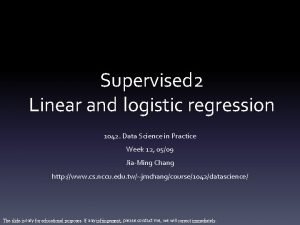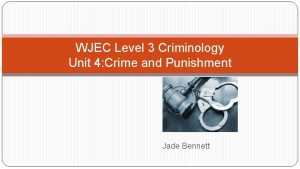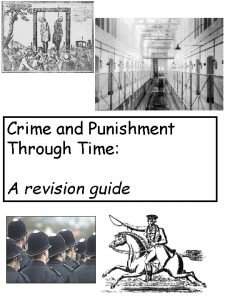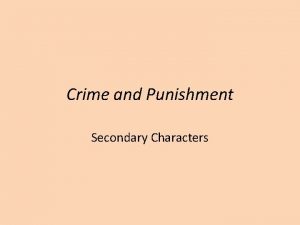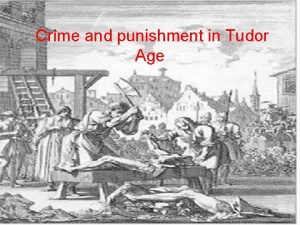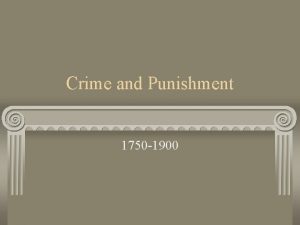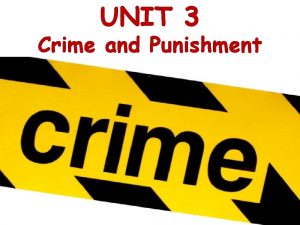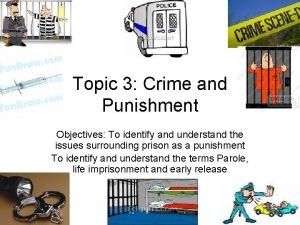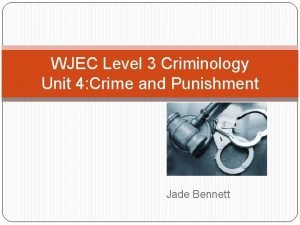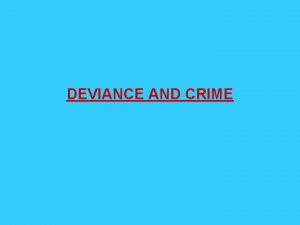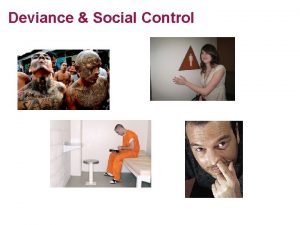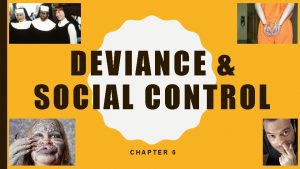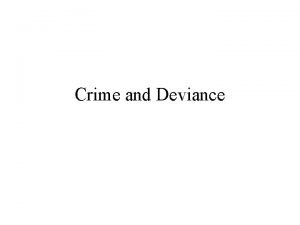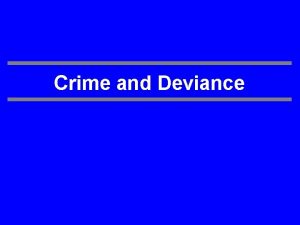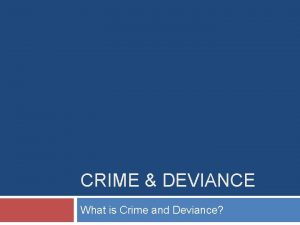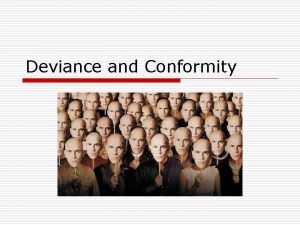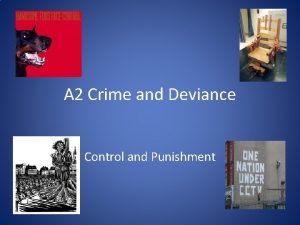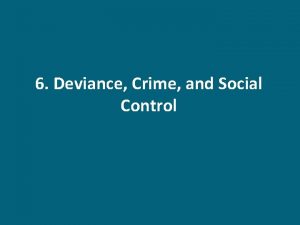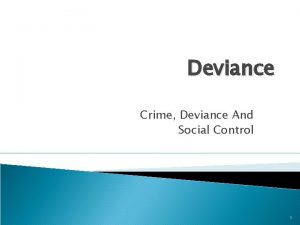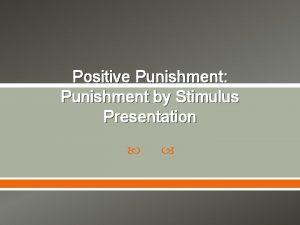CRIME AND DEVIANCE Crime control prevention and punishment




















- Slides: 20

CRIME AND DEVIANCE Crime control, prevention and punishment

Learning Objective: ØTo be able to understand the role of the criminal justice system ØTo be able to describe and evaluate Left and Right Realist explanations for crime prevention and control

Construct: The CJS is responsible for crime control, prevention and punishment. ØTASK – In your booklet, fill in the missing words Answers: 1. Police 2. Crown Prosecution Services (CPS) 3. Prisons 4. Home Office 5. Ministry of Justice 6. Youth 7. Punishing 8. Middle-class 9. Judges 10. White 11. Education 12. Oxford 13. Cambridge

The criminal justice system: The CJS is concerned with four inter-related aims: 1. Deterring people from crime - This is the ultimate aim of the CJS, and in an ideal world it would be so effective that people would be afraid to get caught and therefore deterred from committing crime 2. Protecting the public – it is the primary role of the police to maintain public order and to catch offenders, and the courts, through a wide range of penalties, aim to stop them causing further harm to people or property. 3. Punishing criminal behaviour – this is linked to protecting the public, and is perhaps the most popular conception of the CJS. 4. Reforming or rehabilitating criminals – at the end of the CJS process, after various punishments have been applied, ideally criminals will turn into reformed characters, so that they never offend again.

Crime prevention and control: 1. What are the forms of punishment and prevention taking place in each image above? 2. Which of these methods of punishment and prevention are most effective and why?

Construct: There are two main ways to explain crime prevention and control. These come from: q. Right Realism q. Left Realism TASK – Using the card sort – judge which statements relate to Left Realism and which relate to Right Realism

Construct: TASK – work through pages 4 -9 in your booklet using the textbook

Apply: 1. Explain the difference between target hardening and displacement 2. Suggest two criticisms of situational crime prevention strategies apart from displacement 3. What is meant by ‘zero tolerance’ policing

Right Realism: Environmental crime prevention Hirschi believes that strong social bonds (e. g. With the community) will encourage people to choose conformity over deviance. Policies flowing from this include: 1. Making parents take responsibility for supervision of their children, and socialising them more effectively into conformist behaviour. Those who don’t may be issued with Parenting Orders – court orders for parents to attend parenting classes or counselling 2. Schemes like Neighbourhood Watch, which help to build community controls over time through informal surveillance and ‘good neighbourliness’ – e. g. keeping an eye on each other’s home 3. Cracking down on anti-social behaviour like graffiti, hoax calls, verbal abuse, drug and alcohol abuse, and intimidating behaviour by groups of youths through measures like Criminal Behaviour Orders (CBOs or ‘Crimbos’ and ASBOs.

Right Realism: Environmental crime prevention 4. Supervision of offenders – e. g. electronic tagging and curfew orders to restrict and monitor their movements. Making it harder to commit crime e. g. CCTV and anticlimb paint 5. Adopting zero tolerance policies (‘broken windows’) which involves taking steps against all crime, even low-level offences like graffiti, vandalism, to prevent community breakdown and nip problems in the bud before they destroy a sense of community and individuals come to believe they can get away with offending, and crime subsequently escalates 6. Heavier policing and more arrests, particularly targeted on high-crime areas, to deter potential offending. 7. Fast-track punishment of offenders, with more imprisonment and harsher sentences.

AO 3 – Criticisms of Right Realist crime prevention policies: 1. 2. 3. 4. Zero tolerance policing and a strong police presence in neighbourhoods with high levels of crime may involve a wasteful over-emphasis on minor and trivial offences, which may divert police resources away from more serious crimes which cause greater harm. Labelling theorists suggest that some groups may be targeted and victimised unfairly by police e. g. Police racism; which will lead to a SFP. This was found to be one of the causes of the 2011 riots. They ignore white-collar and corporate crimes, which can have serious consequences for victims They don’t address the wider social causes of crime that Left Realists do. They assume that offenders act rationally in choosing crime and gain benefits from it, but crimes like vandalism, hate crimes, joy-riding are impulsive and do not bring any obvious gain (challenging rational choice theory)

Left Realism: Social crime prevention 1. 2. 3. Preventing crime involves addressing these social issues through policies such as: Policies to reduce the cultural and material deprivation, such as Sure Start, to encourage better parenting, reduce social exclusion and increase social mobility (under the Coalition government Sure Start was abolished) Schemes such as Safer Neighbourhoods where communities work together with the police, encouraging people to pre-empt crimes, e. g. securing their homes more effectively. Building community cohesion and trusting and positive relationships with the police e. g. more public involvement in choosing senior police personnel. Making the police more accountable for their actions.

Left Realism: Social crime prevention 4. Multi-agency working, such as Community Safety Partnerships, where a variety of agencies – such as the police, the local council, and the health and probation services – work together with local people to tackle crime, rather than just relying on the police. 5. Perry Pre school project – Community programme aimed at reducing criminality, Michigan. A group of 3 -4 year olds were offered a two-year intellectual enrichment programme, where they received weekly home visits. The longitudinal study followed their progress and found striking differences with a control group who did not have the programme. By age 40, they had significantly fewer lifetime arrests for violent crime, property crime and drugs, while more had graduated frp, high school and were employed. It was calculated that for every dollar spent on the programme, $17 were saved on welfare, prison and other costs.

AO 3 – Criticisms of Left Realist crime prevention approaches: 1. 2. 3. 4. 5. They are ‘soft’ on crime, as they focus too much on the social causes of crime, and downplay the role of the offender in choosing to commit crime. The offender almost becomes a victim of him- or herself – able to justify their actions e. g. due to marginalisation The explanations are inadequate, as the majority of those living in deprived communities share similar risk factors do not turn to crime - deterministic They deflect attention away from more practical crime prevention measures, like the tighter social control and situational crime prevention that Right Realists suggest. They (like Right Realists) ignore white-collar and corporate crime. Neighbourhood policing, in which police try to integrate themselves into communities as part of community approaches, might be seen as an extension of control and surveillance by the state over the whole population, whether or not they are involved in offending.

Apply


AO 1: As stated in Item A crime prevention strategies aim to “reduce the opportunity for crime”. However, this could be criticised through displacement theory which suggests that these prevention strategies do not reduce crime, they simply displace it. AO 2: Target hardening methods such as “burglar alarms” (Item A) or using CCTV may be reduce crime in that area but it may not reduce crime overall as people will move to where targets are softer to commit crime. Displacement can take several forms, for example spatial: moving elsewhere to commit crime (e. g. where there is no CCTV); temporal – committing at a different time (e. g. if there is police surveillance in shopping centres, people may decide to shoplift late in the evening where there is little police presence); or functional – committing a different type of crime (e. g. rather than burglary, a criminal may steal at car as a means of committing utilitarian crime). Chaiken (1974) found that a crackdown on subway robberies in New York merely displaced them to the streets above (with little CCTV, surveillance available). Therefore showing that crime has not reduced, it simply has moved elsewhere. AO 3: However, this question can be criticised because SCP can be effective in reducing people’s “opportunity for crime” (Item A). Felson found the Port Authority Bus Terminal in New York was poorly designed and provided opportunities for deviant conduct (e. g. the toilets were a setting for luggage thefts, drug dealing, homosexual liaisons). By re-shaping the physical environment ‘to design crime out’ greatly reduced such activity e. g. large sinks were replaced with small sinks to reduce homeless people bathing in them. Therefore showing that SCP can be effective at reducing people’s opportunities to commit crime.

AO 1: As stated in Item A crime prevention strategies assume that the criminal makes a rational decision to commit crime based on perceived risks and benefits. Rational choice theory suggests…. . AO 2: This therefore may explain why SCP may not be effective because it assumes that all criminals make rational calculations. It seems unlikely in many crimes are committed under the influence of drugs and alcohol. For example…. . AO 3: However, this question can be criticised because SCP can be effective in reducing people’s “opportunity for crime” (Item A). ……

Apply (30 marks)

Review: Quiz Trade
 Primary prevention secondary prevention tertiary prevention
Primary prevention secondary prevention tertiary prevention Chapter 7 deviance crime and social control
Chapter 7 deviance crime and social control Logistic regression residual deviance
Logistic regression residual deviance Crime and deviance sociology revision
Crime and deviance sociology revision Difference between crime and deviance
Difference between crime and deviance Myra mawby
Myra mawby Marxism crime and deviance
Marxism crime and deviance Wjec criminology unit 2 revision
Wjec criminology unit 2 revision Crime and punishment revision guide
Crime and punishment revision guide Andrei semyonovich lebezyatnikov
Andrei semyonovich lebezyatnikov Tudor crime and punishment
Tudor crime and punishment Criminology unit 4 exam
Criminology unit 4 exam Medieval crime and punishment facts
Medieval crime and punishment facts Edexcel gcse history crime and punishment past papers
Edexcel gcse history crime and punishment past papers Kahoot crime and punishment
Kahoot crime and punishment Crime and punishment in medieval japan
Crime and punishment in medieval japan Crime and punishment 1750 to 1900
Crime and punishment 1750 to 1900 Criminology unit 4
Criminology unit 4 Crime and punishment key words
Crime and punishment key words Crime and punishment topic
Crime and punishment topic Criminology unit 4
Criminology unit 4


